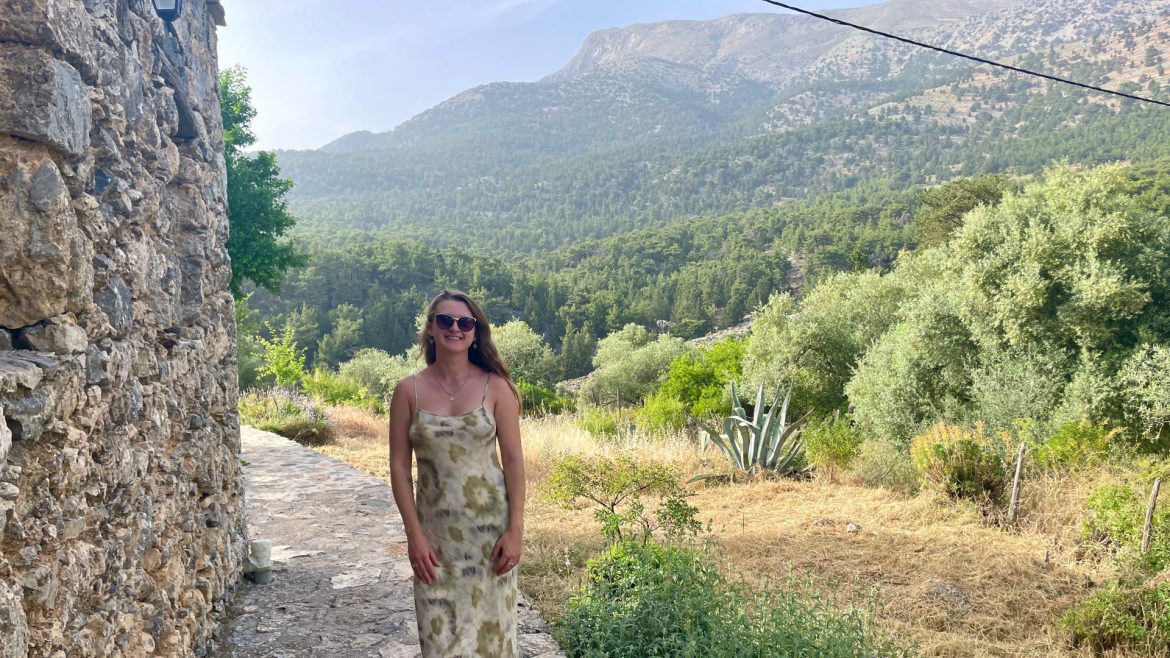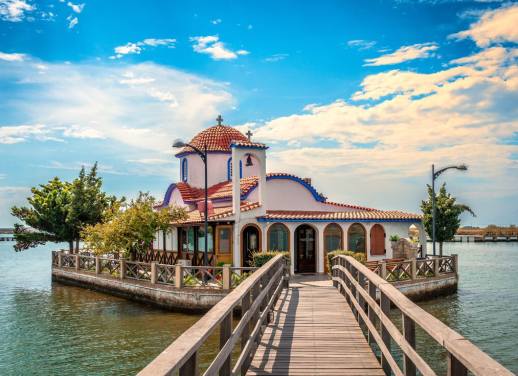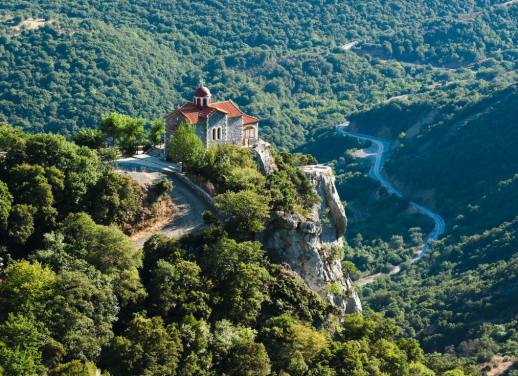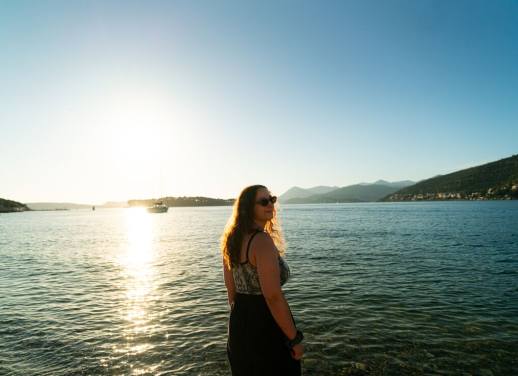Nipping inland away from the beaches, Cliona discovers a heaping serving of hospitality and delicious eats at a locally owned guesthouse in Crete’s White Mountains.
With bellies full of boureki, we peel ourselves from our chairs and head to the minivan. Our group has just finished a hearty lunch at a family-run winery, and while I could easily spend the afternoon sipping wine in the sunshine, we’re bound for the White Mountains which we can see rising in the distance beyond the vineyards.
It’s day two of our seven-day Highlights of Crete trip with Intrepid and we’re headed for a guesthouse in the tiny village of Agios Ioannis. The White Mountains get their name from the snow that blankets its peaks from winter to late spring, only to be replaced by a white glow that reflects off the limestone in the summer.
As we buckle up, our driver, Costos, peers over his shoulder with a beaming grin. ‘OK, are we ready?’ he asks. ‘This is when the winding roads really begin!’ I glance around the group, noting the mild concern on everyone’s faces. The road had been quite sinuous until now – and that was before the wine tasting.
Costos wasn’t messing around. It’s not long until we’re snaking around hairpin bends and staring down at gorges hundreds of metres below. As I contemplate how happy I am that I’m not behind the wheel, unphased mountain goats trot along the ridges, grazing and going about their day.
When we finally pull into our guesthouse, an unassuming but quaint cobblestone cottage overlooked by the mountains, I sense a silent sigh of relief from the group. Our host, Antonis, greets us with a warm smile, slings a few bags over his shoulders and leads us along a path to our rooms. The air smells like lavender and rosemary and butterflies flit between fuchsia-coloured flowers. This is a far cry from the whitewashed villas and coastal resorts most travellers, me included, associate with Crete.


Dodging to duck low-hanging figs, I climb a small staircase to a simple, cosy room with a desk, a double bed and polished logs for side tables – all handcrafted by Antonis with wood from the forests nearby. A wood burner and a basket of woolly blankets stand in the corner, unnecessary in late May but undoubtedly appreciated in winter.
There’s little to do here except plonk yourself on the porch and drink in the view. And even if the rooms did have wi-fi, I wouldn’t want to do anything else. Olive groves stretch in all directions, eventually giving way to slopes studded with pine and cypress trees. The only sounds are bees buzzing and the gentle jingle of goat bells. It’s been a long time since I felt this disconnected from the busyness of life.
If I wasn’t travelling with Intrepid, there’s a good chance I would’ve missed Agios Ioannis entirely and stuck to the well-worn tourist trail. Intrepid designed this trip with MEET (the Mediterranean Experience of Ecotourism), a non-profit organisation that develops experiences to support local communities and conservation as an antidote to overtourism.
The growing problem of overtourism, particularly in the Mediterranean, is causing economic disparity for locals and environmental damage. For travellers, it can also be hard to connect with a place and its people when you feel like ‘just another tourist’. By staying at family-run guesthouses and participating in community-based activities, you get an authentic taste of the culture while spreading the benefits of tourism to places that typically remain off the radar.


Antonis was born and raised in Agios Ioannis and has lived here for most of his life. The village feels worlds apart from the rest of Crete, and at one point not so long ago, it was.
‘The village has changed a lot since I was a child’, Antonis explains. ‘We had no electricity or roads, so mules were our lifeline for transport and farming. It was a two-hour walk to the nearest village before they built the bridge over Aradena Gorge in 1986.’
Historically, most of Agios Ioannis’s few residents were herders or producers who relied on the region’s fertile soils for olive oil, cheese and wine production, but the construction of the bridge opened new opportunities.
‘We got the idea for the guesthouse from a German hiker 25 years ago. He wanted a shelter to take groups up the mountains, so my father and I built a simple dorm-style hostel in my great uncle’s old house. The hiker is very old now, but he still visits us.’
Over the years, Antonis and his wife Anna have expanded the shelter into the seven-bedroom guesthouse it is today. ‘We built the guesthouse by hand, stone by stone, little by little,’ Antonis says. ‘It took 20 years as we didn’t have the funds to build fast.’
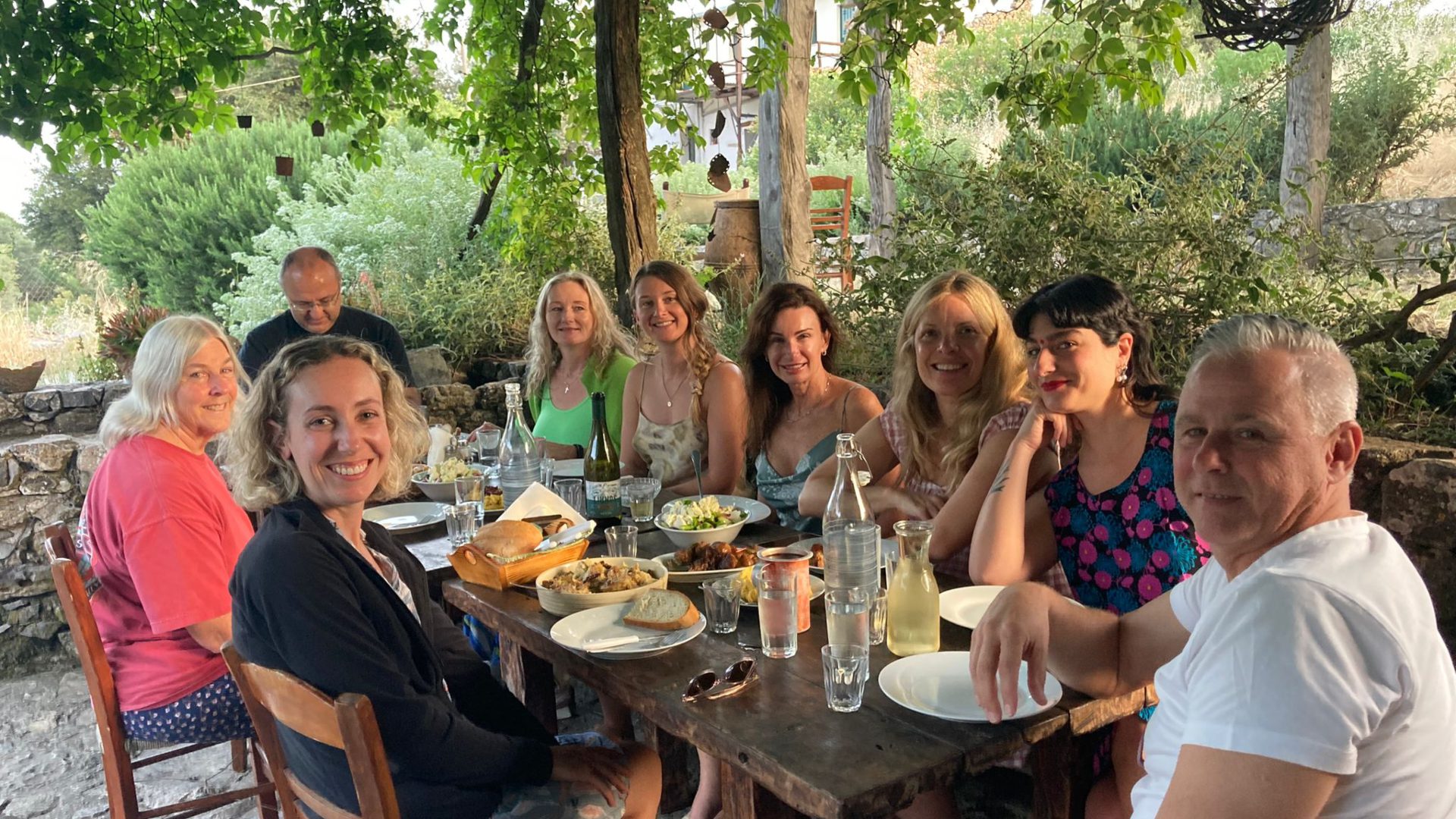
We regroup for dinner at 7 pm on the terrace. Golden hour light trickles through a canopy of vines above our table as mouthwatering smells linger from the kitchen. Anna marches out with platters of creamy fava bean dip doused in local olive oil, slow-cooked pork with red peppers, barbequed goat with what Anna calls grandma fries, and, of course, a big fat Greek salad. I go back for seconds (and thirds), but after just a few days in Crete, I know to always leave room for dessert.
As if on cue, Anna brings out bowls of syrupy semolina and coconut cake while Antonis pours shots of raki, a potent Cretan digestif made from distilled grapes. Supposedly, it helps heal a broken heart. ‘Dieting is mission impossible in Greece!’ Costos exclaims. Yiaimas to that.
Tonight’s feast is the best meal I’ve eaten on the trip so far, which isn’t surprising when I learn that most of the ingredients are grown on the property. ‘We didn’t want to have a taverna,’ Antonis says, referring to the small restaurants you’ll find dotted across Greece. ‘We wanted to cook like we do at home for our family. Everything is homemade with produce from our garden or the village.’


After dinner, two musicians – and friends of Antonis and Anna – treat us to a folk music performance with their lyra and laouto, traditional Cretan instruments. The music is fast and upbeat, rousing a couple of people in our group to dance (helped by the raki, no doubt). But the biggest star of the evening is the musician’s adorable toddler who insists on feeding her dad orange segments while he plays. The whole evening was so intimate. It felt like we were old friends invited into Antonis and Anna’s home.
The following morning, I’m woken up by a choir of cockerels. Anna had prepared a breakfast of fried eggs drenched in olive oil, sfakianopita (Cretan cheese pie drizzled with honey), Greek yoghurt with fruits and nuts, and piping pots of coffee and Cretan mountain tea. I have a visceral reaction to how good the yoghurt tastes.
When the time came for us to bid farewell to our hosts, I found myself feeling not quite ready to leave. Even though we’d only spent one night here, this village has a way of making time stretch. There’s a familiarity, a homeliness, about it.
Within half an hour, we’re in the harbour town of Chora Sfakion surrounded by some of the clearest, bluest water I’ve ever seen. We board a private boat to take us to Sougia, and as we zip along the cobalt blue coast, I relish the feeling of the salty sea breeze on my shoulders. This is the Crete I pictured when I booked this trip. But as I gaze up at the White Mountains that loom overhead, I already know that it’s Agios Ioannis, a tiny village I’d never heard of, that I’ll daydream about long after I go home.
Cliona travelled on Intrepid’s Highlights of Crete trip.

